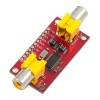Represents a Display Memory Mode value.
More...
#include <max7456Registers.h>
|
| unsigned char | whole |
| | The whole register value.
|
| |
| struct { |
| unsigned char autoIncrementMode: 1 |
| | Auto-Increment Mode.
|
| |
| unsigned char verticalSynchClear: 1 |
| | Vertical Sync Clear (Valid only when clear display memory = 1, (DMM[2] = 1) )
|
| |
| unsigned char clearDisplayMemory: 1 |
| | Clear Display Memory.
|
| |
| unsigned char INV: 1 |
| | Invert Bit (applies to characters written in 16-bit operating mode)
|
| |
| unsigned char BLK: 1 |
| | Blink Bit (applies to characters written in 16-bit operating mode)
|
| |
| unsigned char LBC: 1 |
| | Local Background Control Bit (applies to characters written in 16-bit operating mode)
|
| |
| unsigned char operationModeSelection: 1 |
| | Operation Mode Selection.
|
| |
| unsigned char unsused: 1 |
| | Don't care.
|
| |
| } | bits |
| | access to individual bits
|
| |
Represents a Display Memory Mode value.
| unsigned char REG_DMM::autoIncrementMode |
Auto-Increment Mode.
- 0 = Disabled
- 1 = Enabled
- Note
- When this bit is enabled for the first time, data in the Display Memory Address (DMAH[0] and DMAL[7:0]) registers are used as the starting location to which the data is written. When performing the auto-increment write for the display memory, the 8-bit address is internally generated, and therefore only 8-bit data is required by the SPI-compatible interface (Figure 21). The content is to be interpreted as a Character Address byte if DMAH[1] = 0 or a Character Attribute byte if DMAH[1] = 1. This mode is disabled by writing the escape character 1111 1111. If the Clear Display Memory bit is set, this bit is reset internally.
access to individual bits
| unsigned char REG_DMM::BLK |
Blink Bit (applies to characters written in 16-bit operating mode)
- 0 = Blinking off
- 1 = Blinking on
- Note
- Blinking rate and blinking duty cycle data in the Video Mode 1 (VM1) register are used for blinking control
| unsigned char REG_DMM::clearDisplayMemory |
Clear Display Memory.
- 0 = Inactive
- 1 = Clear (fill all display memories with zeros)
- Note
- This bit is automatically cleared after the operation is completed (the operation requires 20us). The user does not need to write a 0 afterwards. The status of the bit can be checked by reading this register. This operation is automatically performed: a) On power-up b) Immediately following the rising edge of RESET c) Immediately following the rising edge of CS after VM0[1] has been set to 1
| unsigned char REG_DMM::INV |
Invert Bit (applies to characters written in 16-bit operating mode)
- 0 = Normal (white pixels display white, black pixels display black)
- 1 = Invert (white pixels display black, black pixels display white)
| unsigned char REG_DMM::LBC |
Local Background Control Bit (applies to characters written in 16-bit operating mode)
- 0 = sets the background pixels of the character to the video input (VIN) when in external sync mode.
- 1 = sets the background pixels of the character to the background mode brightness level defined by VM1[6:4] in external or internal sync mode.
- Note
- In internal sync mode, the local background control bit behaves as if it is set to 1
| unsigned char REG_DMM::operationModeSelection |
Operation Mode Selection.
- 0 = 16-bit operation mode
- 1 = 8-bit operation mode
| unsigned char REG_DMM::unsused |
| unsigned char REG_DMM::verticalSynchClear |
Vertical Sync Clear (Valid only when clear display memory = 1, (DMM[2] = 1) )
- 0 = Immediately applies the clear display-memory command, DMM[2] = 1
- 1 = Applies the clear display-memory command, DMM[2] = 1, at the next VSYNC time
| unsigned char REG_DMM::whole |
The whole register value.
The documentation for this union was generated from the following file:


 1.8.3
1.8.3